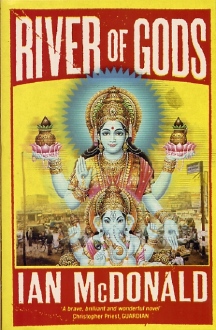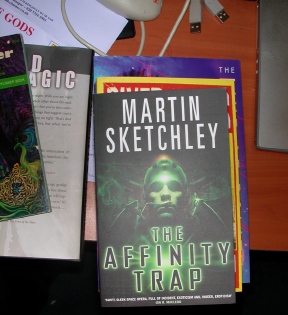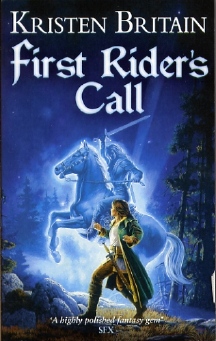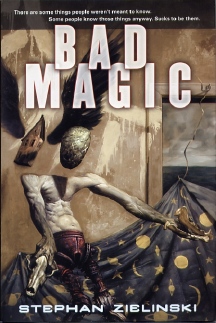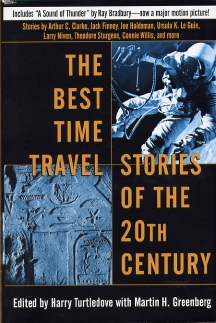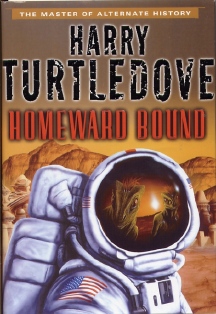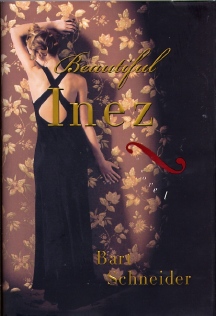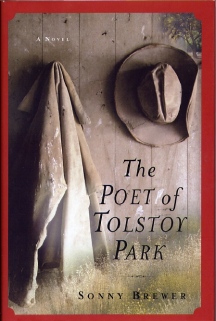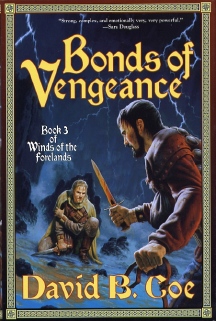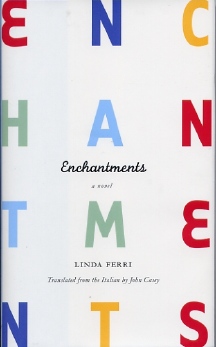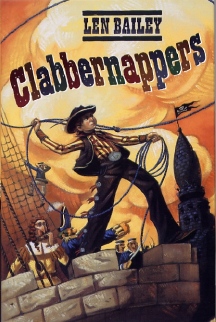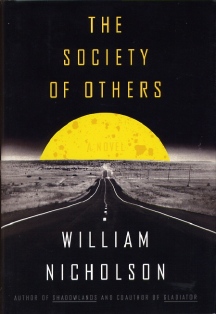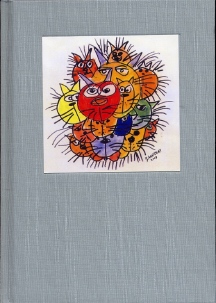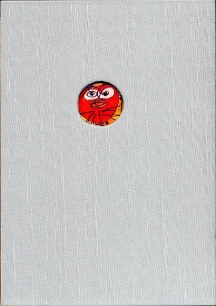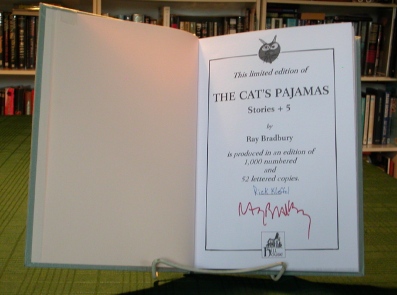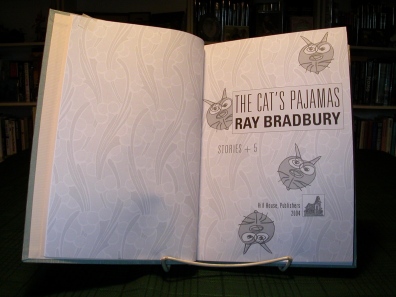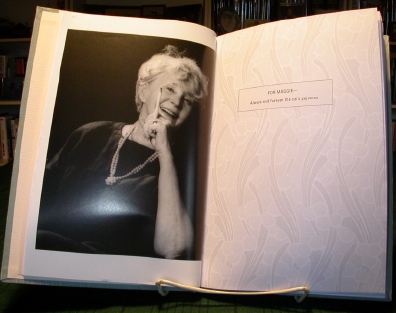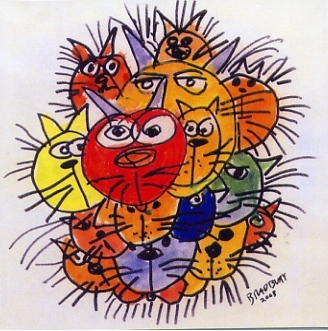|
|
|
This Just In...News from the Agony Column
|
02-18-05: Yeehah! Big Ol' SF&F Roundup |
||||||||||||||||||
Probably
Part One
For example, I almost forgot to remind you that the folks at Thunder's Mouth / Avalaon wrote to tell me that Lucius Shepard's 'A Handbook of American Prayer' has sold out. Gone. Whoosh. Buy one now or risk a re-print -- if they actually do re-print them. And trust me, you don't to wait for a re-print. So, going in order of when they came, you're going to have to wait for the Sub Press and the McSweeney's goodies, and damn theyre really good. Be that as it may, we can start things off with bang, a mere forty-two years in the future. Yes, I'm talking about one of my ten best from last year -- and a book that frankly gets better in my memory every moment and begs to be re-read -- Ian McDonald's 'River of Gods' (Pocket Books / Simon and Schuster UK ; 4 April, 2005 ; £7.99). I'm sorry, according to the release you may have to wait for this, but it is definitely worth waiting for. In fact, I'd suggest you go out and get first edition hardcover now, and then when this extra-ordinary paperback comes out buy that to read and loan to your friends, keep the hardcover pristine, because it's going to be a collector's item. This is a superb novel, totally immersive, involving and wonderfully mind-boggling. McDonald keeps things just blurry enough, keeps the many threads of the plot just barely in sight so that you can really sink into and enjoy the utter strangeness and familiarity of the future he's created. Check out my earlier review, and better yet, the interview I did with McDonald. He's a brilliant writer and fascinating guy. And then let me add this. This is a book you'll remember fondly reading, then want to re-read, so that you can once again enjoy that thrill as McDonald, with amazing prose and skill, brings together his many threads in a thrilling finale.
So here's a brand-new paperback format for this chunky novel. The paper is also a grade between whet you get in a trade paperback and a mass-market paperback. The price is quite close to that of a mass-market paperback -- £7.99 as opposed to £6.99 for the MMPB and £10.99 for the trade PB. This is a great format, affordable, but a lot more readable than a mass market paperback. I hope to see a lot more publishers and authors getting this format, because a large part of the pleasure of reading is enjoying the text itself. That's much easier if it's big and easy-to-read. Only one done? It's 10 AM already? Where does the damn time go? Now it's 10 gods-damned 30! All I did was change out the wash and answer the phone! I literally cannot type fast enough, which of course is perfectly clear to my readers who have to put up with an inordinate number of typos, though Terry 'D'Auray eventually gets a gander at this stuff and helps me achieve something remotely resembling literacy. Where was I? Right, UK mass-market paperback slab o' fantasy, in this case, Kristen Britain's 'First Rider's Call' (Pocket Books / Simon and Schuster UK ; 7 March 2005 ; £6.99). This is a follow-up to her first novel, no, not Zeroeth Rider's Call, and not 'Null Rider's Call', which sounds better -- 'Green Rider' was her first novel, and 'First Rider's Call' follows hot on the heels of that book. So, if in theory this one sounds good, you'll want to read that one first, and, conversely, if you've read that one, apparently, you're going to want to read this one. Because, against all odds, it sounds pretty good.
This book offers 639 pages of pretty small print to get yourself lost in. It also offers very short chapters to make reading all the easier. I like that in a big fat old book. As much as I might have wanted to toss this one off as boilerplate fantasy, I think that it looks better enough than the rest of the pack to be worth your valuable time, especially if you want to read a fat fantasy series featuring a no-doubt strong female character. If this is a BART book, then it's a BART book you want to keep. Looking for a slim hardcover you call your own? Why not discover Stephan Zielinksi's oh-so-delectable tale of 'Bad Magic' (Tor / Tom Doherty Associates ; December 1, 2004 ; $23.95). From Jon Foster's surreal cover art to the twenty-plus page Appendix this book demands that you run out, buy it NOW and read it NOW. I havent even read more than a few pages and already I can say that most, if not all of the readers of this site will enjoy this book. I mean, what's not to like? Here's the premise, and don't stop me if you've heard this before. Magic is real, and most of us can't see it, and dont know about it. And to quote the clever cover blurb, "Some people know these things anyway. Sucks to be them."
This looks like the kind of book you read on a rainy afternoon, giggling and swilling beer. Well, if you're me, anyway. Alas, no matter how much twisted the fiction I churn out each morning, it seems that I don't fully use up my inner cackles. I can imagine that those who sleep between 3:30 AM and 6:00 AM might have a huge backlog of goofy cackling to exorcise, and this book looks like the perfect method to do so. Buy, buy it now and don't wait until first editions are going for $75.00 because it's been optioned by some nebbish Hollowood producer. Back on the more expected side of things, you can find Martin Greenberg and Harry Turtledove's 'The Best Time Travel Stories of the Twentieth Century' (Del Rey / Ballantine / Random House ; January 4, 2005 ; $17.95). Apparently the time travel starts with the book itself, which didn't appear until well into the twenty-first century. Presumably it took them a long time -- ahem -- to decide what should go in there. This is the third anthology in a "Best of the Twentieth Century" series, the first two covering Military Science Fiction and Alternate History. I'm going to go out on a limb here and say that the cover is one of the most difficult to read and least appealing covers I've seen on any book of late. Were I to see it in a bookstore, I'd look away and the type -- tastefully spread across two boring photographs -- would remain blissfully unread. In fact, it doesn't even look like a finished cover, more like a mock-up for a cover.
As the bold white stripe across the top of the cover promises, it does include the Ray Bradbury classic 'A Sound of Thunder', which is soon to be unveiled as what looks to be a fairly dire full-length motion picture. Those of us who have read the story might think that it would make a great fifteen-minute movie. At say, 82 minutes, you've got to guess that it's either been embedded in so much fat that it will be the science fiction equivalent of 'The Nutty Professor' or, it's been warped beyond all recognition, as if someone has traveled back in time and meddled with the story itself, and the unintended consequence of that meddling with the story is some abominable movie. That said, I'll be there to see the movie, because the preview I saw featured what is probably the only ten seconds of semi-watchable footage that had a cheesy CGI monster. Yes, some things are important, and seeing cheesy CGI monsters is at the TOP OF THE LIST. In an alternate timeline, I can already feel my mind melting. Wait, that's a different anthology! I'm already in an alternate timeline! What the hell? I just hope my TCP/IP connection to the original Agony Column server works. Probably in this timeline, I'm what -- a sports nut or something? Probably I run a big hip-hop review website. If that's the case, I hope someone in this alternate timeline will put me out of your misery. I'm not kidding. I'll write about hip-hop if I have to.
What I liked about the WorldWar series was that though Turtledove took his characters and his situation very seriously, his situation was set up to allow a fair amount of humor. Inept alien conquerors are not a common theme in science fiction, and I sure as heck dont know why that's the case. Turtledove nails both a sense of wonder and a sense of humor, sometimes in the same concept or incident. This is very clever, written very slickly and is lots of fun. It may not be the greatest book or series ever written, but Turtledove is rock-solid dependable in his ability to deliver a page-turning bestseller-style slab of science fiction. Long, long ago, I asked my wife to buy me the first book in hardcover, and I've been collecting and reading them ever since. Well, that covers about the first half of what I've got on the shelves, as you've seen if you've taken a gander at them lately. Probably not many changes today, but I'll faithfully photograph them and post the results. And be typing as fast as I can for Monday, stay tuned! |
|
02-17-05: 'Beautiful Inez' by Bart Schneider and 'The Poet of Tolstoy Park' by Sonny Brewer |
||||||
The
Life of the Arts
Bart Schneider calls his new novel, 'Beautiful Inez' (Shaye Areheart Books / Crown Publishing / Random House ; January 24, 2005 ; $24.00) a "companion novel" to his earlier novel, 'Secret Love'. OK, perhaps you're gacking on the titles, but give the guy a chance. Schneider has some very interesting credentials to bring to his stories. He's the founding editor of 'Hungry Mind Review' and 'Speakeasy' magazine. His first novel, 'Blue Bossa' was a finalist for the Los Angeles Times Book Prize and 'Secret Love' was a New York Times Notable Book. The Hungry Mind Review was a book review journal before the name was spirited away by some pop band. Like Speakeasy Magazine, it came from The Loft Literary Center in Minneapolis. Both focus on literary fiction and poetry and have a track record reaching back to the 1980's. 'Beautiful Inez' is Inez Roseman, your average tormented artist. That is, she's a brilliant violinist with the San Francisco Symphony Orchestra, has a successful husband, talented children and persistent thoughts of suicide. Set in the early 1960's, 'Beautiful Inez' is informed by Schneider's father, who himself was a violinist with the San Francisco Symphony Orchestra. Schneider tells us that his father auditioned for the orchestra "the day before he was going to New York to study with a great violin teacher in hopes of being a soloist." Instead, Schneider's father chose a steady gig in San Francisco. It turned out to be the right choice, because, his father said, "my temperament was right for the symphony." In Inez, Schneider has created a character who makes the same choice but has the wrong temperament. This what-if thought experiment is a great way to make a character, to infuse them with life based on actual experiences and yet fueled with the invented changes required by virtue of the author's changes. Schneider was eleven years old in 1962, when the novel is set, and he draws extensively from his own life and his father's life to create an authentic portrait of high art in very high times. As one might imagine, life in the symphony orchestra was not the main focus of life in San Francisco in 1962. The world was on the verge of momentous change, much of it originating there. Inez meets her match in Sylvia Bran, whose obsession with Inez matches Inez's obsession with suicide. She contrives to meet Inez and the two embark on a torrid affair, which is probably what will get the most press attention. But Schneider wants much, much more than that; he's aiming for high literature on the level of 'Memoirs of a Geisha' and 'The Hours'. I've read his dialogue and it's quite sharp. He easily captures the rhythms of a family. His prose has a deft, witty quality that I find a lot more appealing than I expected. The book looks, against all odds, just a bit funny, mordant, and quite pithily entertaining. Writing about artists is a gamble, but Bart Schneider looks to be a smart bet. He apparently has both sides of the "writing about artists" problem under control. His artist in this novel is certainly an interesting character -- and she wants to run over herself with the car. No need for me to drive in to 'Beautiful Inez'!
So what is Sonny Brewer's 'The Poet of Tolstoy Park' (Ballantine Books / Random House ; March 1, 2005 ; $21.95) doing in The Agony Column? It's the power of persistent marketing. Brewer is showing up at Capitola Book Café, with much fanfare. Fortunately for me, my defenses were worn down, because while the book may actually fall under some of those descriptive tags, Brewer and his subject have a hell of a lot going for them. If the name "Sonny Brewer" sounds familiar to the bookerati, that's because Brewer is the famous owner of a famous book store, Over the Transom in Fairhope, Alabama. Furthermore, he's edited the annual anthology series, 'Stories from the Blue Café: Anthologies of Southern Writers'. But he's also the series editor of 'The Alumni Grill', which I wrote about last year, a tempting anthology whose first installment was edited by William Gay. Brewer will pick the subsequent editors, and a guy who comes out of the gate with William Gay is my kind of guy. So, we've got the writer's credits checked, and they look quite impressive. What about the dig-dagged book itself? Even a good writer with impressive credentials can churn out a spiritual book. But 'The Poet of Tolstoy Park' has more going for it. The novel is based on the life of Henry Stuart. In 1925, Stuart was 67 and a resident of Canyon County, Idaho. He was a retired professor and a widower. His doctor told him he had about a year left, and that he'd be well advised to move to San Diego, where the warmer climate would make life more tolerable. So like any ornery old coot, he moves instead to...wait for it...Fairhope, Alabama. I guess the connection is becoming clear. But Fairhope had a lot to offer back in 1925, compensation for the fact that Over the Transom wasn't yet over the transom. It was a Southern town populated by oddball idealists, including Upton Sinclair, Sherwood Anderson and Clarence Darrow -- and in fact Darrow starts the novel. Readers will recall that I've praised another Darrow-oriented work, 'Big Trouble' so it's natural that I'd be interested in this one. Once in Fairhope, Stuart doffs his shoes, walks around barefoot in the freezing cold and somehow manages to thrive, thwarting disease and inept medical diagnoses. His last few months became years, and he became a fixture in town. All of this unfolds with the care of Brewer's skilled prose. Like many a book you might be inclined to run away from, should you pick this one up and read it, the appeal will become clear. Now I'll admit that this book sounds a bit off the path I usually beat. But then, once in a while it does the brain good to get out and around. Somewhere in my aging collection of 1980's 45 RPM singles I even have a record by a band called the Tagmemics, produced by Gong bassist Mike Howlett. The A-side song is titled 'Take Your Brain Out for a Walk'. Of course, having done so, one is well advised to put the damn thing back where it belongs and get back to the basics of cheesy science fiction, fantasy, mystery and horror. You have to take your inspiration where you find it, yes. But sometime you have to look where you would otherwise be certain none is to be found. You know. Take your brain out for a walk. |
|
02-16-05: The Extremes of Fantasy |
||||||
David
Coe's 'Bonds of Vengeance' and Linda Ferri's 'Enchantments'
David B. Coe won the William C. Crawford Award for best First Fantasy for 'Children of Amarid' which kicked off his first fantasy series, 'The Lontobyn Chronicle'. Now you, like myself, might wonder what the heck the William C. Crawford Award is. Should it influence our buying habits? First off, though Tor might tell you it's the William C. Crawford Award, it is in fact the William L. Crawford Award, and it is awarded by 'The International Association for the Fantastic in the Arts', so in theory, the novel 'Enchantments' has a shot. According to their web page, "The IAFA is a scholarly organization devoted to the study of the fantastic (broadly defined) as it appears in literature, film, and the other arts." Well, I'm surely using a broad definition, aren't I? The IAFA has been around since 1979, when Robert A. Collins organized a Conference on the Fantastic at Florida Atlantic University. They publish 'The Journal of the Fantastic in the Arts', which is in its 13th year of publication. They're apparently rather large and well funded. The IAFA Conference this year will feature Rudy Rucker, recently mentioned here with regard to his newest novel 'Frek and the Elixir', Damien Broderick, John Kessel and "Permanent Special Guest" Brian Aldiss. That's a pretty stellar roster. These guys deal in respectable, highbow literature and genre fiction. it's quite impressive, and the Alex Irvine, author of 'A Scattering of Jades' acts as an associate editor for The Journal of the Fantastic in the Arts. More important to get a bead on this William L. Crawford Award is a list of the previous recipients. In fact, it's a pretty wildly variable list, including Charles De Lint (author of 'Spirits in the Wires', Sharon Shinn, Chitra Bannerjee Divakaruni (author of 'Queen of Dreams'), Anne Bishop, and Jasper Fforde (author of 'The Eyre Affair', 'Lost in a Good Book' and 'The Well of Lost Plots'. Crawford himself was an editor back in the 1950's from what I can dig up. But were one to jump quickly to the conclusion that the William L. Crawford Award is given only to tried-and-true, genre fantasy, youd be way off base. The presence of Chitra Bannerjee Divakaruni speaks to that, and as well to the potential for a writer like Linda Ferri to be in the running. So give Coe full credit for winning the award in 1999. 'Bonds of Vengeance,' the third book in his 'Winds of the Forelands' series, begins as "accidental" deaths explode into violence. The Qirsi people have the ability to reach into the minds of others, even when those others sleep. A mysterious Qirsi who calls him or herself the Weaver is turning Qirsi against Qirsi in an attempt to overthrow the Eandi lords. Grinsa is a Qirsi gleaner, traveling with Lord Travis. The murder of Travis' bride set the tumble towards war in motion. Think Archduke Francis Ferdinand, whose murder set our world upon a course towards the First World War. Grinsa, Travis, and Grinsa's sister Keziah are trying to avert the Forelands version of trench warfare. Coe's specialty, we're told, is dense historic-feeling fantasy. Though it's only 414 pages, 'Bonds of Vengeance' has a rather smallish typeface that's surprisingly easy to read. And it appears that Coe packs a lot of military, political and magical shenanigans into his novel, the kind that fantasy readers really enjoy. When he started, the series was projected to contain four novels, but now it looks like five, which as far as fantasy bloat goes, isnt too bad. Following hot on the heels of 'Bonds of Vengeance' will come 'Shapes of Darkness' and finally, it is hoped 'Weavers of War'. Having won best first novel, one wonders whether some conference is out there fixing to be born, just so it can award a "Best Last Novel in a Series" award. But would that mean that a single, standalone first novel of fantasy could qualify for both awards? While the notion may sound fantastic, it's certainly not beyond the bounds of reality.
As a fantasy, 'Enchantments' has a lot to recommend it. While fantasists often create another world for the action to transpire within, that world is usually external to ours, different from ours. 'Enchantments' creates the world within a child's mind, a world that is by definition fantastic, and then sets about slowly and steadily whittling away the fantasies of childhood. Ferri gets quite deeply and naturally into the child's point of view. What she excels at is having her narrator tell the reader quite a bit about the world surrounding her that the narrator herself does not understand. What to the little girl appears as magic, to the reader appears as life. The reader knows that sometimes when people go away and dont come back, it's because they've died or lost someone they loved. The child creates a fantastic version of these events, or simply observes them without noting the import. For me this type of writing is one of the most pleasurable types to read. It takes an incredibly skilled writer to pull it off, and it can easily fall flat. But Ferri has a nice, deft touch. More importantly, you can pick this one up in the bookstore and read enough to get a quick idea as to whether or not it's your kind of fantasy. But do note that it is some kind of fantasy. Of course, in the most general sense, all fiction is fantasy -- if it's not, it's non-fiction. But there's a certain category of writing that captures the everyday fantasies we have while simultaneously capturing the reality that those fantasies are avoiding. It tells us not just about the world without, but the world within. And there are no greater extremes that one can find. |
|
02-15-05: William Nicholson in 'The Society of Others'; Len Bailey's 'Clabbernappers' |
|||
We're
Not in Chicago Anymore, Danny Ray
The signs thus far are quite straightforward, and they indicate that soon, young adult fiction ("Enjoyable for adults too!") will be the only type of fiction available. You might conclude after seeing the venerable adult-oriented M for Mystery Bookshop open up an annex dedicated to selling children's fiction. It's a smart move for this smart bookseller. They're really tied in to the publishing industry, and you can bet that if an author appears in Northern California, chances are they'll show up at M for Mystery. What not take advantage of that connection and dragoon the ever-so-profitable YA authors when they show up in town? After all, M for Mystery already has a highly dedicated adult reading customer list. If anyone's kids are going to be reading, one might think, it will be the children of those who buy their books at M for Mystery. At least, if you were in the marketing business and had no children you might think that. You can't blame a bookseller for extending their line, especially when there is already so much crossover between the adult readers and the YA readers. And most especially when you have the connections that M for Mystery clearly has. Tor is moving into the YA business as well with 'Clabbernappers' (Starscape / Tor ; February 3, 2005 ; $17.95). But frankly, I think theyre overestimating the age range that is going to be interested in this novel. Well, overestimating and underestimating. Danny Ray is an eleven year-old boy on a winning streak at an amusement park near him home in Oklahoma. When he breaks a record in a balloon-popping game, the proprietor offers him a chance to step through a door marked ADVENTURE. Danny takes up the challenge and ends up not in Oklahoma but in Elidor, your non-standard-issue fantasy realm in turmoil. Turns out there's a chess game, adventure on the high seas, and room for an eleven-year old boy to save the day and rescue the Queen. Though you might want to stick this into the Young Adult section, to my mind, 'Clabbernappers' will have a distinctly schizophrenic appeal. On one hand, precocious readers from the fourth through the seventh grade may find this precisely what they're looking for. 'Clabbernappers' has easy, not too easy to read prose, lots of action and lots of humor. But with that young a protagonist, the youthful side of the audience is going to be very youthful. Halo-playing hipsters drenched in virtual gore are not likely to adopt this book. On the other hand, the influences here, clear as the day, are quite sophisticated and speak well to an older audience that enjoys simpler fiction. Fans of the Oz books, for example -- and there are many of them -- should definitely give this book a gander. And Bailey has inked in links to C. S. Forester, the super-popular Patrick O'Brien, fantasy icon E. R. Eddison and of course, with a chess-playing theme, Lewis Carroll. The creatures and characters have a bit of the feel of Clive Barker's 'Abarat' books as well. So while 'Clabbernappers' is likely to appeal more to the pre-teen than the young adult audience, it might also find favor in those adults who delight in the work of L. Frank Baum and Lewis Carroll. Take a look around you and see if you can find a bookstore that does not stock these classics, and then you'll understand the potential. With publishers convinced that reading is a dying pastime -- and I'm not so sure I'd agree -- they're following the example of the cigarette manufacturers and hoping to hook an audience while they're still young. They're right in thinking that the reading habit, once established early in life, is a lifetime habit that only gets worse as it the reader grows older. Eventually the reader ends up with piles of books to read. Tor is sparing no expense. They're putting out some stellar books, and they've got a to-die-for lineup working for the Starscape imprint. Take a look over at the website and see if you dont agree. They've re-purposed Orson Scott Card's classic 'Ender's Game' and nabbed material from fantasy bestseller Robert Jordan, science fiction superstar Jerry Pournelle, fantasy legend Jane Yolen and more, many more. This is not a passing thing for Tor. All they need now is their own version of Joe Camel. |
|||
Defying
Rational Expectations
What you might not expect is that the co-writer of 'Gladiator', William Nicholson, is the noted playwright who adapted his own play 'Shadowlands' into a movie starring Anthony Hopkins as C. S. Lewis. His latest play, 'The Retreat from Moscow' was nominated for three Tony awards, including best play. He's also written a fantasy trilogy for children -- are you sensing a theme here? -- titled 'The Wind on Fire'. Well, the theme here is that William Nicholson can clearly write well. And that can only add to the intriguing nature of 'The Society of Others' (Nan A. Talese ; January 18, 2005 ; $23.95), Nicholson's first novel. Nicholson's first-person narrator is willfully unnamed: "I'm not going to tell you my name. If you want a name, use your own." At the age of 22, ol' unnamed, seized by the desire to do something, to do anything, sets out to hitchhike through Europe. He gets picked up by a truck driver, and crosses more than one kind of border. He may be in Eastern Europe, or he may be in some sort of ultimate no-man's land. Cars crash. Political parties collide. "There is no middle ground between terrorism and order." Pliers and electrodes crop up, all in the name of surreal terror. The mean streets are not just mean, they're unnamed as well. "Write something about yourself, then write the opposite. Then open your mind to the possibility that the second statement is true." 'The Society of Others' is hardcore action masquerading as art. 'The Society of Others' is art masquerading as hardcore action. That's a decision that readers will have to make for themselves. But Nicholson has written some substantial material and clearly has the chops to turn out something more than a Euro-trash rampage. And fact of the matter is, hell, a well-done Eurotrash Rampage might go down a treat. This novel appears to have a cultivated, purposeful pointlessness, you know, they came, they saw, they kicked ass, got drunk, puked and left. Certainly, those whose reading consists mainly of "Lather, rinse, repeat" will find something resonant here. And what could be more appropriate for road reading than a novel on traveling mayhem? Every niche group gets a bestseller in the fullness of time. Perhaps those who travel with a meth lab in their back seat can travel with 'The Society of Others'. And if they get pulled over, they can simply tell the cops, "That's a meth lab. That's not a meth lab. You want to read a great novel?" |
|
02-14-05: On Saint Valentine's Day, Hill House Demonstrates Why We Love Reading |
||||||||||||||||||||||
A Close-Up Look at Ray Bradbury's 'The Cat's Pajamas'
Like most readers of speculative fiction, Bradbury's work was some of the first and most memorable I encountered. From 'The Veldt' in 'The Illustrated Man' to 'The Small Assassin' in 'The October Country' to Mars in 'The Martian Chronicles', I read through Bradbury's work early and often. For me, at least, memories of reading books are pretty important. A book is a very specific way to connect with a time, a place or a feeling. Once you pluck the title from your mental index, it's like pulling the plug from a pipe that allows all the other memories -- the smells, the colors, the temperature, the place, the voices of the people around you -- to flow out, it bursts the memory dam. Be that as it may, memories of reading specific books often evoke different feelings. You flash back on the day you read 'Starship Troopers', and you're going to feel like you're in the middle of battle. You flash back to the day you read 'Childhood's End' and you'll feel like you're in a particularly vivid museum -- 'Childhood's End' indeed. I can still picture the day when I bought my first paperback copy of 'Dune'. It was fall in Southern California, and though the sun was shining, there were huge gray clouds being swept through the skies, and the world felt in the grip of fierce, unrelenting change.
"Look baby. Something pretty. Something bright." A scalpel. Chilling indeed. The baby has just murdered its parents, and is about to be murdered itself by the doctor who brought it into the world. Yet, for all the cold calculation, there's a warm sense of emotion running through everything that Bradbury writes. No matter how horrific, no matter how cold, no matter how awful, it's quite clear. Bradbury loves the worlds he creates with words. That's why I can flash back on the children murdering their parents in with the virtual lions that roamed 'The Veldt' and not feel like a killer or a victim. That's why I can visit the small American towns that Bradbury's explorers encounter on Mars. Because no matter how wrong the worlds of his creation, he created them with loving care, he imagined the warmth within before he brought the chills. I actually met Ray Bradbury, back in the day. He was attending a performance of the stage play version of 'The Martian Chronicles' that ran in Los Angeles during the late 1970's. He was a generous, friendly guy who happily signed my program and talked with my friends and I. I remember him reaching towards me with a hand to shake and a smile on his face. So we flash forward some thirty years. Now my kids are the ones with giant TV's and VR. I can guarantee you that we're not watching the many Animal Planet and National Geographic specials on veldt predators, not on our large screen TV mind you. Now I find myself picking up the Hill House Publishers' version of Bradbury's latest, 'The Cat's Pajamas', knowing that I'm creating new memories in my own house, with my own children. As you might imagine, having seen articles on Hill House publishing's work, it's a pretty sweet deal. It's what I needed to bring back that warm rush, a simple title to tie to this day, this house, these times. Of course, Hill House allows readers to experience that rush in a variety of ways that the old paperbacks -- or even, most of today's new hardcovers -- cannot compare to. I'll start from the outside in, with this proviso -- there's a lot of outside and it's a very nice outside. As usual, Hill House ships their books in a keepable cardboard box. It's not just keepable, it's shelvable, as readers who have been keeping track of my rolling bookshelves can attest. The spine of the box offers more information, clearly labeled and easily readable from a distance than the average shipping box. Title, Author, Publisher and ISBN are all easily viewed before you've even popped the hood. Once you pop the hood...
You'll not find the book, but rather, the Wrapped Book. No, it's not a Christo-wrapped book, though I wouldn't be surprised to see the famous artist contributing to the high profile, high-quality Hill House line. Hill House covers both their books and their slipcases in a soft, Japanese silk cloth called "Elegance Slub". In order to minimize chafing by the cardboard during shipping, they're now wrapping the slipcased book in "inert white paper".
Now, next up, you can remove the book from the slipcase quite easily because one) the slipcase is perfectly fitted to the book. This is not always the case with slipcased books. I have some that are positively impossible to dig out, and not just because the books are old and bloated, though I've a few of those as well. (Notably, my first thirty-plus year-old copy of the trade paperback release of 'Lord of the Rings' and my Bantam Adult Fantasy version of 'Gormenghast'.) It's not going to happen here. Hill House also includes a silk slipcase puller-thing (is there a technical term for these?) that allows the reader to finally, at long last, having delved through all the lovely layers, get to the nut within the shell, the book itself. And as to the book...Well, you can finally see Ray's artwork, which nicely helps the catapult back to your adolescent days. The pages are thick and slick, the signature page that starts it all simply and elegantly designed. That same design continues through the title page, and more importantly, through the dedication to Ray's late wife, Maggie. Since I first read most of my Bradbury in the late 1960's and early 1970's, the photo of Ray's late wife is the perfect compliment to those times. Maggie and her cigarette could have been any one of a hundred moms or teachers from my childhood. Hill House tipped in the photo without Ray's knowledge. He didn't know until he held the finished book in his hands. It's the perfectly poignant Bradbury feel, the Bradbury spin that Hill House -- and only Hill House, I must add -- is able to, is inclined to add in their books. Care takes time, takes precision and every bit of this book is amazingly engineered. It all fits together, it all flows together.
It's a quiet Sunday afternoon. It's cloudy in Aptos. We're expecting rain, and likely to get it sooner than the weatherman predicted. I'm going to plant myself in my reading chair, light a fire, and make some memories. I'm going to read 'The Cat's Pajamas'. Ray Bradbury and I go way, way back. But this is a two-way street. I'm going forward as well. Into the future. Reading Ray Bradbury in front of the big-screen TV. No documentaries on veldt predators for me, though. |
